Kids Web Japan
Web Japan > Kids Web Japan > Meet the Kids > Japanese Dance > The Lesson
Meet the Kids
Japanese Dance
The Lesson
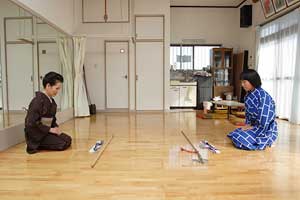
The greeting at the start of the lesson is very important.
Greeting the teacher
In Japanese dance, each school has its own teaching style. In most schools, students learn the basic postures, foot positions, ways of using the props, and other gestures for the dances by studying individual pieces decided by the school.
Most students take private lessons, and the most important part of the lesson is the greeting. At the beginning and end of each lesson, the teacher and student sit across from each other in the formal seiza position, with their backs straight and legs folded under them, and they bow low to each other. When they bow, their towels are placed in front of them, folded in half widthwise and in quarters lengthwise, on top of which lies the fan. The fan is a sacred object for students of dance, since it is believed to have Buddhist significance as an object that divides the sacred space of the practice room from the outside world. This is why it is said that "Japanese dance lessons always begin with a bow and end with a bow."
Yumika takes her place across from her teacher, Kawahara Mitsuru, and pays respect to her at the beginning of the lesson. Her towel and fan are placed in front of her, along with the gold stick she is now using for her practice.
Imitating the teacher
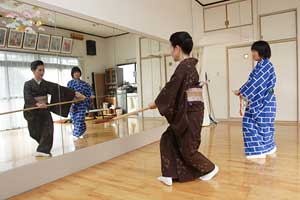
Yumika closely follows her teacher's movements.
Yumika is currently working on an original seven-minute piece called "O-matsuri (Festival)" for a performance in July. It is a difficult work that tells the story of a festival. It features a combination of "masculine" and "feminine" steps set to nagauta (a lyrical song accompanied by shamisen music used in kabuki dance).
The lesson begins with Yumika's teacher dancing in front and Yumika imitating her movements. The dance is broken down into many sections. In one section, she appears on stage as a young man holding a golden stick, and in another she performs men's dance steps using the golden stick. Yumika practices these sections over and again.
Guidance
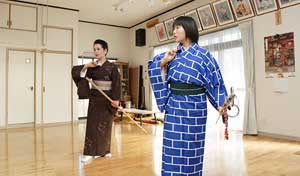
Attention must be paid to the gaze and feet even when just walking.
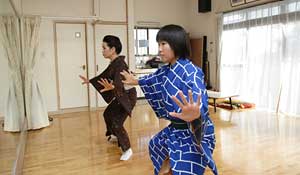
Tension fills the room.
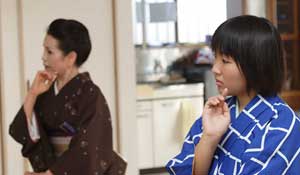
Yumika adjusts her movements as she checks herself in the mirror.
Once Yumika knows the dance from start to finish, it is time for her teacher to point out her mistakes. "Don't drop your gaze. Look straight ahead - as if you're searching for somebody." "Walk with style, as if you're trying to cut the wind with your shoulders." Yumika's teacher is particularly strict about the opening scene, when she appears on stage. When her teacher tells her something, Yumika practices the movement until she gets it right, checking herself in the mirror.
Yumika receives detailed advice from her teacher on using the gold stick and towel, positioning her head and feet, and other points. After each piece of advice, Yumika repeatedly practices the movement. Though she and her teacher are the only two people in the room, their enthusiasm fills the air.
From start to finish
In the second half of the lesson, Yumika must try dancing alone, without her teacher. After appearing on stage dressed up as a young man, she dances with the golden stick and later puts on a mask and dances the role of a joker and then a homely woman. Little by little the hustle and bustle of the festival become apparent.
Yumika dances with total concentration and without a break until the end of her forty-minute lesson, which takes place once a week. Only after the final greeting does she breathe a sigh of relief.